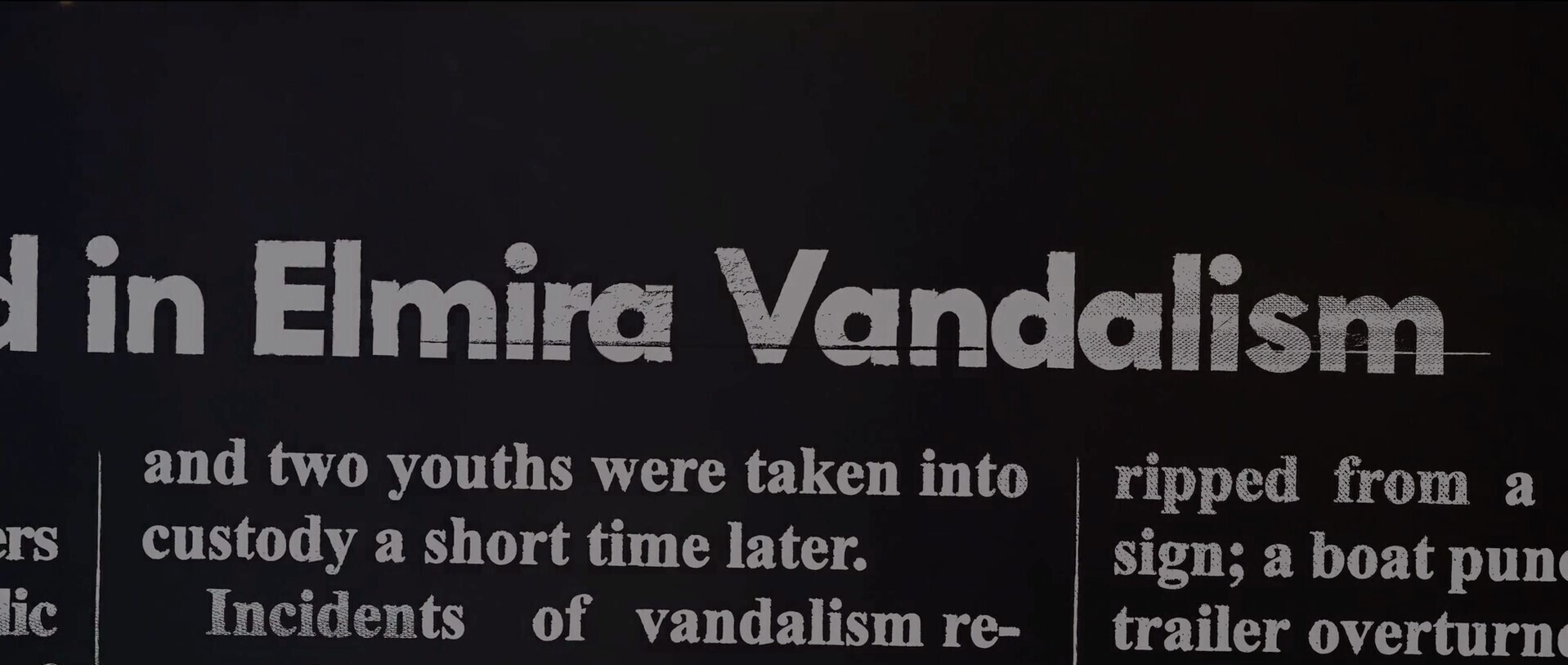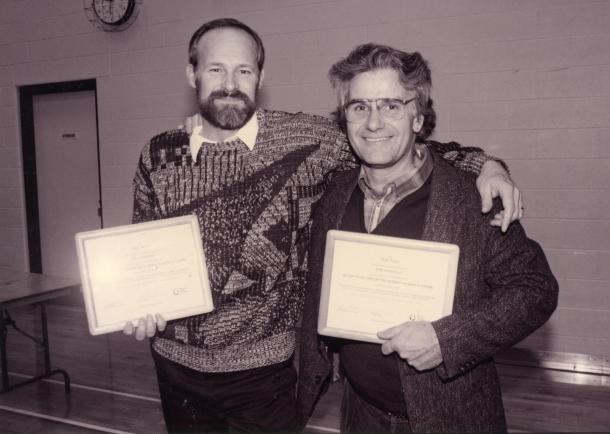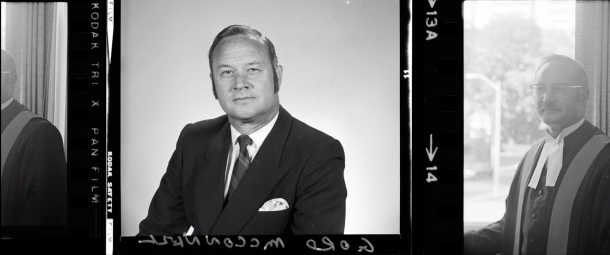Resorative Justice's birth in the Canadian legal system

Article text originally published in 1986 as Part 1: Reconciliation Begins in Canada in MCC Peace Section Newsletter, Volume 16, Number 1. Adapted for web by Renata Buhler. MCC acknowledges that, while this was one of the first documented cases of the victim-offender reconciliation process within the Canadian justice system, the early models of the restorative justice process were adapted from Indigenous practices which were used on the land we now call Canada and around the world among Indigenous communities long before this documented case.
Two young men in Ontario, Canada, could hardly have known their willful damage of property on May 22, 1974, would uncover a new way to deal with criminal offenders. They had damaged cars, slashed tires, and broken windows causing $2,200 of damage to 22 properties in the community of Elmira, Ontario, nearly $12,000 when adjusted for today's inflation. But there were two men from Mennonite Central Committee (MCC) Ontario, Mark Yantzi and Dave Worth, who were not willing to let criminal justice take its usual course.
At that time Yantzi was a probation-parole officer for Waterloo Region in Ontario. During a meeting on May 22, 1974, to discuss the Christian response to shoplifting, the locally famous Elmira case came up for discussion. “Wouldn’t it be neat for these offenders to meet the victims,” Yantzi said to the group. “I knew that didn’t happen, that it was a pie-in-the-sky idea. But it was a safe audience, so I said it and then dropped it. I went on with the pre-sentence report I had prepared.”

Dave Worth, another participant in the meeting, said, “I am ready for the pie-in-the-sky idea.” He liked the practical peacemaking implications of offenders and victims getting together. Yantzi, however, did not think such an idea had a chance with the judge and recalled feeling the tension of, “Do I want to risk my reputation in suggesting a negotiated settlement between victims and offenders that has no basis in law?”
Six days later, on May 28, the Elmira youths each pleaded guilty to 22 different charges, including damaging cars, slashing tires, and breaking windows. Two churches and the Brewers Retail store were included in the properties damaged. The judge remanded the young men out of custody while Yantzi prepared pre-sentence reports on them.
Neither had any prior criminal record and Yantzi gained a favourable impression of the youths from the interviews. Because of the large number of people involved in the case, he suggested in his report that “some therapeutic value” could come from “confrontation” between the offenders and the offended.
The established way of dealing with the offender left out the possibility of giving the victim a face. It also left out a chance for the victim and offender to make arrangements for restitution, face-to-face with a mediator present, and perhaps be reconciled.

The search for an alternative form of justice
MCC Ontario had been probing for alternatives to the criminal justice system. In 1968 they appointed a study committee to come up with a non-bricks-and-mortar concept for dealing with offenders.
“We felt the criminal justice system simply could not sustain the number of people it was putting away,” recalls Doug Snyder, who leads the committee. “We wanted to try to bring into reality a way for our congregations to be more involved in the ‘hands-on’ way of meeting human need.”
When Mark Yantzi walked into Snyder’s office in 1968, Snyder asked, “We need a pioneer. Do you have the interest?” The answer from Mark Yantzi and his wife Glennis Yantzi was yes. Negotiations with the Ministry of Correctional Services led to Mark Yantzi’s placement as an MCC-supported volunteer with the Waterloo Region Probation Department in 1969. He was assigned to develop community programming. What community programming meant at that stage was that Yantzi and Snyder met once a week over lunch “to figure out the next move,” according to Snyder.
Yantzi's work at this stage focused on organizing volunteers to help in probation. Within a year of starting the assignment, he accepted the offer to fill a vacancy as a probation-parole officer, with the understanding that he would continue to be a resource to the committee. Worth then became the MCC-appointed volunteer coordinator to continue the developing involvement with the Ministry of Corrections.
Up to 1974, this team continued to think about how forgiveness and starting over without forgetting the past could both be central concepts in an alternative to the criminal justice system as it was operating. The church had both the knowledge that people need a community to become whole as well as the people to help give the idea shape; how could the two be brought together in the interests of a truer justice?
One little bit of right direction at the right time and they are kept out of the court system forever."
Judge G.H. McConnell
The search for an alternative ranged from examining existing church and non-church programs aimed at working with current and former inmates to developing programs that emphasized resolution outside of court through community mediation.
Between 1969–1974 the team's effort received the full support and encouragement of Yantzi's superior, John Gaskill, who was familiar with British penal reform of the early '70s in which experimentation was being made with community service sentences for certain offenders.
Judge Ross Fair, then a family court judge, also gave support in providing orientation for some of the volunteers found in the churches. The team members, consultants, and volunteers themselves helped give shape to an idea that was about to be born—an idea that had reconciliation as its goal.
Assessing the damage and making amends
The sentencing judge in the Elmira case, Judge G.H. McConnell, was not immediately enamoured with the idea of “therapeutic value.” One of his first responses was, “That can’t be done,” Yantzi recalls.
Yet the face-to-face meeting of offenders with victims to work out restitution is what Judge McConnell ordered. Accompanied by their probation officer or the volunteer coordinator, the boys knocked on the doors of the 22 people who had suffered willful damage at their hands. They were able to contact all but two, who had moved.
“Our approach was pretty brutal in those days,” Yantzi recalls. “We walked up to the door. [The boys] knocked. We stood back with our note pads.”

On August 26, 1974, the boys reported their findings to the judge. They were fined $200 each and placed on probation for 18 months. The judge made it a term of their probation that each would pay restitution of $550 within three months, as arranged by the probation officer. It was the first sentence of its kind.
The disposition of the case had opened what is now called the Victim Offender Reconciliation Program (VORP). VORP identifies crimes that would normally lead offenders into the criminal justice system but can successfully be dealt within the community. Once people in the community are involved, VORP seeks to effect reconciliation and understanding between victim and offender and facilitate an agreement for restitution. Ultimately it assists offenders in paying their “debt to society” directly to whom that debt is due—the victims.
A little bit of right direction
Judge McConnell brought to the sentence and the idea something only a judge can give: “Bench sense.” In his five years as a judge he had taken a different tack in sentencing in two cases, he said. In the first, he ordered a youth to prepare a report of theft in the schools, “for the sheer purpose of finding some other alternative that was available.” When the judge got the report back, he was astounded at the number of misspelled words. “I told the lad, ‘I’d like you to go home and correct the spelling.’ The assignment hit the national media.”
In another case, Judge McConnell sentenced a youth who had damaged a car wash to work there on Saturday mornings. “I wanted the individual to really experience and understand what he had done. The fine was related to being penalized for breaking a law.” Many times, Judge McConnell said, all someone needs is “one little bit of right direction at the right time and they are kept out of the court system forever.”

What does Judge McConnell say to the role of the church in keeping persons out of the courts and out of prison? “The church has less influence on the world today than it ever had,” he said. The church’s influence on the average person, particularly in the area of teaching and showing the biblical injunction to “Do unto others as you would have them do unto you,” he said, “doesn’t seem to be a major factor at all anymore.”
What does the executive director of MCC Ontario say about the church taking a different track in risking its love and reputation in working alongside the criminal justice system? The director, Ray Schlegel, sees the church’s theological stance as keeping it from being co-opted. The church’s calling, he said, has to do with applying “Christian principles to the areas that affect society’s weak, broken and maladjusted. In North America that brokenness shows up in courtrooms and prisons.”

